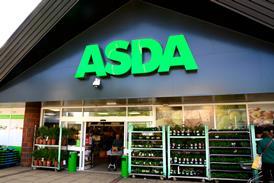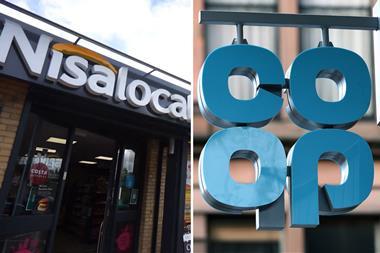Ian Locks, PPA chief executive, and Robin Dickie, md of WH Smith UK Retail Channels, go head to head for readers of The Grocer over the wholesaler's proposals for a national distribution system for magazines
Locks: Newspapers and magazines are just like baked beans, aren't they? Manufactured items sold within a specified time frame at a negotiated margin to the retailer...
Actually, no. There are some pretty fundamental differences and to multiple retailers in particular these differences can be rather irritating.
It is because newspapers and magazines are different that we are seeing the current spat between WH Smith, the retailer/wholesaler, and publishers.
It started when WH Smith, with 18% of the magazine retail market and 40% of the wholesale share, got together with Tesco in the early summer, when magazine publishers were told they would have to supply both retailers through WH Smith News.
The new Smith's service for multiples, called national distribution, would create a super pipeline for a select group of around 7,000 retailers within the 55,000 universe of news outlets. The super pipeline, carrying around 60% of magazine retail sales value, would offer a new range of services requested by the multiples, such as a single invoice, common standards and systems and sales based replenishment.
But at the same time it would destroy the supply chain to the majority of independent outlets by undermining the viability of the current system of regional wholesalers.
This was highlighted by national newspapers, independently of magazine publishers, who commissioned a survey by Professor Paul Dobson of Loughborough University. It found that up to 20,000 outlets would find it too costly to continue to sell magazines and, as publishers feared, if the system was extended to newspapers up to 12,000 would be forced to close.
Both WH Smith and Tesco had been at pains to emphasise that they were only targeting magazines for national distribution. National newspapers were not convinced. The Dobson report confirmed earlier investigations by the OFT and Monopolies and Mergers Commission that the distribution of newspapers and magazines is intrinsically linked. For a start they usually arrive on the same trucks.
While newspapers have shown little real RSV increase over 10 years, magazines have soared by around 128%. And, crucially, both products are supplied to retailers on a sale or return basis.
It is these arrangements which ensure the diversity of choice and the widest possible availability of newspapers and magazines and keep open many thousands of rural and independent retailers. The distribution of 1,000 newspaper and around 3,500 magazine titles is the most complex of any distribution system, given its huge daily volumes, the patchwork of 3,500 titles and variety of frequency all offered on sale or return according to a recent study by the Freight Transport Association.
Nevertheless it delivers greater efficiency than the average for perishable products in supermarkets, according to a report part-funded by the DTI. Add to this the understanding that up to 50% of magazines and nearer 70% of newspaper sales are through the independent outlets which WH Smith's proposals would threaten, and the resistance of publishers and increasingly of independent retailers and MPs to the WH Smith plan becomes clearer.
But there is more. Under WH Smith's national distribution regime, the super pipeline would effectively be controlled by WH Smith and a few major grocers. It is they who, ultimately, could control which newspapers and magazines reached the market.
Of course they would never actually seek to control the Press in this way, would they? Study recent history. Delisting of titles by individual retailers is not uncommon. If someone has the power to control the only effective route to market can you guarantee such power will never be used?
Should a free Press allow itself to be placed in such a position? That, says the Press with almost unheard of unity, is just not on.
Tesco was the first to acknowledge this and has since met with the magazine industry organisation, the Periodical Publishers Association, to find an alternative way of meeting its needs and those of other retailers.
The Periodical Publishers Association came up with "Blueprint" which offers all the benefits of the WH Smith national distribution but without the downside of independent retailers' closures.
The key to this is the continuance of the regional wholesaler network while developing a new Central Publications Unit to handle centrally the information systems needed by all sides of the industry to develop e-commerce. Retailers have acknowledged that the PPA Blueprint specification would be able to meet their requirements for improved service. Unfortunately this does not so far include WH Smith Retail.Sixteen suppliers, including TNT and Royal Mail and existing wholesalers individually, have bid to be the preferred supplier of the Central Publications Unit and the winner will be chosen in January with the new service starting from April 1.
The PPA Blueprint can deliver the benefits sought by the multiple retailers in a realistic timeframe. It is an intelligent solution because it meets the needs of all retailers while serving the needs of the rest of the industry and, ultimately, the consumer.
The Blueprint offers the best way forward for the country as a whole, preserving jobs, maintaining the tradition of the small, independent newsagent, particularly those in rural locations, and upholding the principles of Press freedom.
It also responds to the exhortations of Cabinet and other government ministers who have urged the industry to resolve its differences in a way which does not restrict freedom of choice of newspapers and magazines.
The Press, with the greatest deference to baked beans, is just a little bit different.
Dickie: In recent months WH Smith, in conjunction with other retailers, has sought to modernise and improve the magazine supply chain. The key driver behind this impetus for change is the desire to reduce wastage and improve efficiencies by creating choice for retailers over key aspects of the supply and delivery of magazines.
The case for change in the magazine supply chain has considerable support from retailers, both large and small. In a survey conducted by MORI almost 75% of independent retailers interviewed said their businesses would benefit if they had a greater say in the appointment of their magazine suppliers.
The Association of Convenience Stores has also given its support for the drive to improve the efficiencies in the supply chain for national distribution, along with the British Retail Consortium.
Magazine retailers, both multiples and independents, want to be able to influence the choice and service standards of their own magazine supplier. More competition in the supply chain will mean better service standards as a result of competition; improved systems resulting in more ready availability of magazines and less waste; a single source of supply, reducing complexity and duplication of process and reduced costs.
Under the present structure, magazine publishers appoint wholesalers with exclusive distribution rights for their titles in a geographic region. The publishers determine which magazine titles will be supplied to each store, how many copies will be supplied, the selling prices and supply terms.
This creates problems for many retailers. For example the retailer may currently have to deal with three or four different wholesalers appointed exclusively by publishers which creates an administrative burden which costs retailers about £54m every year.
Many retailers are unable to obtain supplies of some titles. Other retailers sell out and can't get further copies, restricting consumer choice. These lost sales opportunities represent up to £36m annually.
In the absence of any other solution being created to address these issues, a national distribution proposal was developed by WH Smith and other retailers. The PPA accepted that this proposal provided an impetus for change and addressed the main issues inherent in the current system.
However, the PPA did raise some concerns and, in response, WH Smith agreed to work with it to modify national distribution in a way that provided a solution for other retailers and, at the same time, considered the publishers and wholesalers issues. This led to the development of Blueprint.
The progress that Blueprint has achieved has been welcomed, but retailers, including WH Smith, still believe that there are significant retailer issues that need to be properly addressed:
- The need for retailers to have direct trading relationships with publishers
- The right of retailers to be involved in the choice of their Central Publications Unit (CPU)
- The achievement of an efficient network through one physical delivery per store.
In spite of claims by the PPA, WH Smith has remained open to creative solutions to these issues and has tabled a number of suggestions. However, WH Smith has been concerned by the apparent reluctance of the magazine publishers to fully address the concerns of the retail industry.
There has been a lot of speculation about the potential impact of a national distribution solution. This has been based on the claims of Professor Paul Dobson, in a report commissioned by the Newspaper Publishers' Association.
WH Smith has challenged his assumptions and predictions, as has The British Retail Consortium and Frontier Economics, commissioned by Tesco. WH Smith believes that even if Professor Dobson's worst-case scenario is accepted, his estimates of the costs of change are insignificant compared to the huge financial benefits that would be achieved by having a more efficient supply chain.
Recent comment in the media has questioned WH Smith's commitment to independent newsagents. As a wholesaler, WH Smith News is committed to independent retailers for good business reasons. They represent over half of WH Smith News total sales and a strong independent sector provides a healthy balance to the multiples.
In addition, WH Smith has invested over £25m in projects to ease the administrative burden for independents including EPOS and Connect 2U, a business to business trading portal. Furthermore, WH Smith News has made a commitment to maintain supply of magazines and newspapers to all WH Smith News' customers and to supply any other retailer, subject to publishers maintaining existing supply arrangements with WH Smith News, and reasonable commercial considerations.
Contrary to the suggestions of recent press reports, newspaper distribution is not included in the proposed changes to the supply chain.
Magazine wholesaling is fundamentally different from newspaper wholesaling, which operates to nightly deadlines and has a small range of titles with a short shelf-life.
WH Smith believes the system works well and has no desire to change it. All of our actions, despite misrepresentation to the contrary, have been intended to update this important category and to prepare for the challenges of the future. We hope for a solution which does involve and meet the needs of all relevant parties. This is a unique opportunity to modernise the magazine supply chain which we are not prepared to miss by failing to address the issues both fundamentally and properly.
{{FEATURES }}
Close menu
- Home
- Retail & Wholesale
-
Products & Suppliers
- Back to parent navigation item
- Products & Suppliers
-
Product Categories:
- Back to parent navigation item
- Product Categories:
- Alcoholic drinks
- Bakery
- Cereals & breakfast
- Cheese
- Chicken & poultry
- Chocolate
- Confectionery
- Crisps, nuts & snacks
- Dairy
- Fish
- Fresh produce
- Frozen
- Household
- Meat
- Own Label
- Sauces & condiments
- Seasonal
- Soft drinks
- Vaping
- Vegan & plant-based
- World foods
- Suppliers
- People
- Reports & Data
-
Topics A-Z
- Back to parent navigation item
- Topics A-Z
-
Popular topics:
- Back to parent navigation item
- Popular topics:
- Cost of living crisis
- Crime
- Deposit Return Schemes
- Finance
- Government & Regulation
- Health
- Inflation
- Loyalty
- Marketing
- Mergers & Acquisitions
- New Product Development
- Sourcing
- Supply chain
- Sustainability & environment
- Technology
- Ultra Processed Foods
- Vaping
- A-Z all topics
- Content by type:
- Events
- Subscribe now
Sign in to comment on this article
Not logged in before? Register for FREE guest access today.
You will be able to:
- Read more stories
- Receive daily newsletters
- Comment on stories
Advert
Related articles
More from News
Most popular
Latest
© William Reed Ltd 2025. All rights reserved.
Registered Office: Broadfield Park, Crawley RH11 9RT. Registered in England No. 2883992. VAT No. 644 3073 52.
Website Terms | Privacy Notice | Cookie Statement | Cookie Preferences
Registered Office: Broadfield Park, Crawley RH11 9RT. Registered in England No. 2883992. VAT No. 644 3073 52.
Website Terms | Privacy Notice | Cookie Statement | Cookie Preferences
Site powered by Webvision Cloud


































No comments yet